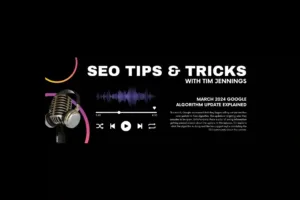Search Engine Optimization (SEO) is a tricky puzzle that is always changing. Search engines, such as Google, are always changing their algorithms and they give very little information about them. Their secret algorithms make it hard for even the best SEO experts to manage and maintain a lead on the competition. But there is some good news! There are definitely some sure-fire things that you can start doing now to help your website remain in good standing with search engines and can help you get found by users.
When thinking of search engine optimization, there are commonly two types people refer to: On-page SEO and off-page SEO. This article is focused on on-page SEO.
Here is a brief overview of some of the things we do to help our clients with content and on-page search engine optimization:
1. Create and Submit A Sitemap
After your website is live you will want to create a sitemap. A sitemap, as defined by Google, is a file where you can list the web pages of your site to tell Google and other search engines about the organization of your site content. Search engine web crawlers like Googlebot read this file to more intelligently crawl your site.
To submit your sitemap you will want to go to the different search engines and use their webmaster tools to upload your sitemap and select the different options on how you prefer they “crawl” your website.
2. Keyword Research
Unfortunately, keyword research is often the most overlooked step when creating content and it is, in our opinion, by far the most important step. When thinking about content for your site ALWAYS do keyword research and find out what people are searching for before actually creating the content.
There are many free tools available to use in order to find the best keywords. Here are four of our favorites:
Do your research. It will be worth it. Think of as many different ways to say what you are trying to get across as possible and research which ones are the best. NEVER TRUST YOUR GUT! You will find more often than not, your gut will be wrong.
3. Title Tags
After you do your keyword research you will know what to name things. Use those Keywords in title sections of your page. This is where many people try to get too clever. Don’t get us wrong, an eye-catching title is nice but if you are writing an article about tips on how to keep your swimming pool clean, a title like “A Paradise In Your Own Back Yard” just isn’t smart. No one is searching for any of those words when trying to get tips to keep their pool clean.
4. Image Titles and Tags
Image Titles
An image title should never be “logo-header” or “Eli-small-150×150”. Those titles should be named after keywords as well. If you own a swimming pool company, then your logo should be titled “XYZ-Swimming-Pool-Services-Logo.”
When considering other images within your website, your image titles should be associated with the concept of that content. So if the content on your website is about tips on keeping your pool clean, use the image title “pool-cleaning-tips” or whatever keyword you have found that has a high search rating. Continue this with every single image on your site. You should always use the keywords associated with that particular piece of content in the image’s name.
Image Alt Tags
An Image Alt Tags is a tag that should let the user know what an image’s content and purpose are. These alt tags are used to describe an image to a user who may not be able to see your image due to a visual disability or if their browsers are displaying content in pure text forms instead of images. An easier way to think about it is than an alt tag serves a similar purpose for those who are visually impaired as subtitles do for a person who is hearing impaired.
These alt tags should contain your keywords as well as descriptions of your image. Write these alt tags in complete sentences and without dashes. Keeping with our swimming pool example, a great image alt tag would be “Pool cleaning tips. Image of a clean swimming pool in someone’s backyard.”
5. Content
CONTENT IS KING! Search engines love content! The more the better. PUSH IT OUT! Blog as much as possible and use keyword research for those blog titles, images, etc. They don’t have to be long articles, but a good general rule of thumb to remember is that they should be at least 300 words. You would be surprised how easy it is to produce a 300-word article or blog post. At the end of this sentence, this post will have had 835 words.
When writing, place those keywords throughout the body of the content. You don’t want to over do it, so use them so that it comes off naturally for the user while they are reading your content.
You also need to write in a way that a user is used to talking. You may need to throw out some of that MLA Formatting and Styling that you were taught in high school. Don’t be afraid to start a sentence with the word but. A user wants to read in the manner that they speak. They will continue to read longer if you write that way; which decreases your bounce rate and, in turn, increases your SEO score.
6. SEO Meta Keywords
If you want international traffic to your website, Add SEO meta keywords, descriptions, and titles to wordpress pages (if possible).
Many SEO experts say that meta keywords are useless. And in North America, they aren’t wrong. However, in countries overseas like Asia and the Middle East, search engines continue to use meta keywords as a way to crawl your website.
On-page SEO overview
So there you have it. Above is a list of our general rules and tips when starting to think about search engine optimization. Still have some questions? Need some help with your business’ SEO? Contact us today and we would love to schedule a time to give you some tips and help you out with a content strategy or SEO help!





